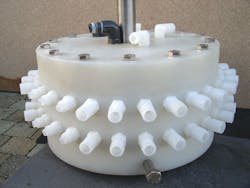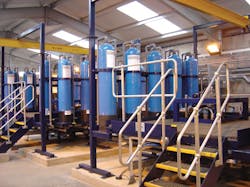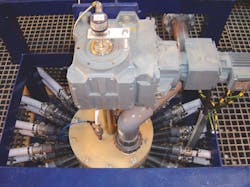Ion exchange technology removes nitrates from drinking water
The Belgian separations technology company PuriTech designed an ion exchange system that improves liquid–resin contact efficiency while reducing plant operating costs and capital expenditure. Targeted at a broad range of industries, one area where the system is now showing its strength is in the removal of nitrates from drinking water. Filip Rochette of PuriTech explains…
Filip Rochette
Nitrate contamination of drinking water is a growing problem worldwide. Associated with certain health problems and damaging to aquatic habitats, nitrates must be removed from water to meet strict regulations in place to protect people and the environment.
In developing Ionex, PuriTech decided to build on and dramatically improve existing systems, particularly those based on the continuous countercurrent process, and extend the range of applications in which the technology can be used.
Standard, existing technologies include fixed-bed, and both continuous and continuous countercurrent ion exchange systems. Based on a batch-style operation, fixed-bed units are used in around 90 percent of ion exchange projects, but their performance is relatively weak compared with continuous countercurrent systems. Furthermore, they waste two to four percent of the treated fluid flow in water treatment applications.
Continuous ion exchange, which makes use of an array of automated valves for each resin cell, offers an improved approach and some advantages, but relies on a lot of piping and complex controls. Two major companies have developed continuous, countercurrent ion exchange units that use a turntable, or carousel, to rotate the resin cells around a central valve. This also requires complex controllers, and the use of flexible hoses between the valve and resin chambers.
Based on innovative valve design, Ionex effectively reverses a commonly used approach to distributing fluids to ion exchange cells. Ionex uses a single, multi-port distribution valve (see top photo), creating a process system for continuous, countercurrent ion exchange. The patented valve distributes different flow streams to several resin cells and determines whether the resin is in an adsorption, a regeneration, or a rinsing cycle.
The technology is markedly different from other continuous, countercurrent ion exchange systems that are available in the market place. Instead of using a turntable to move the cells around a central valve manifold, the process disc within the Ionex valve rotates around a central axis and distributes the different flow streams to the cells containing ion exchange resin or other adsorption materials. Each cell is subjected to an entire sorption cycle during a full rotation.
Adsorptive and ion exchange separation generally comprises a two-phase mass-transfer – an adsorption cycle and a desorption cycle – separated by washing or rinsing of the solid phase between these mass transfer steps. The use of shorter and smaller resin beds allow for maximum resin usage.
The mass-transfer zone in a standard ion exchange plant is typically a small section of the actual operating bed length. This small production section, where mass transfer takes place, passes as a transfer zone throughout the bed from a saturated resin to an unsaturated resin.
To avoid frequent bed regeneration, the content of a vessel is saturated before regeneration takes place. Each regeneration follows a batch sequence. Countercurrent contacting on a continuous basis does not suffer these limitations, because it is not a batch process.
Application meets guarantees
The PuriTech system, recently used in a municipal water supply project in East Anglia, UK, met its performance guarantees. An analysis of plant operating data for a period of six months shows that power consumption, waste production, and chemical usage were all considered to be extremely low, compared with conventional methods of nitrate treatment.
The system uses nitrate-selective resin to adsorb nitrates present in the raw water. Traditionally, resin would be packed into a large fixed bed and raw water allowed to flow through for a certain length of time (depending on nitrate levels) before the bed has to be taken off-line for regeneration.
The system is a true counter current ion exchange system in which part of the ion exchange resin is continuously removed and regenerated, and then returned to the treatment system. This approach eliminates long periods of down time for regeneration while maintaining consistent effluent characteristics.
PuriTech's design offers other advantages. Rigid pipes can be used between the valve and ion exchange vessels (see top photo), and sealing is greatly simplified, which means only O-rings and gaskets are required. In addition, a simple control unit can be employed because the system does not use a carousel.
Compact systems based on the technology can be built. The ion exchange cells can be positioned in any desired pattern, providing maximum installation flexibility. Ionex can be retrofitted to an existing ion exchange system, regardless of where the ion exchange cells are placed.
The system is also designed to be adaptable and versatile. A number of user functions can be carried out simultaneously under continuous operating conditions. Easy access to the valve, the system's only moving part, and the ion exchange vessels, simplifies maintenance procedures.
Growing markets
Plants based on Ionex technology are set to displace some fixed-bed units, and even other countercurrent systems, which are now in use because they are more cost-effective and require a smaller investment. Further market opportunities for the system include replacing “old generation” multi-port valves.
Ionex is targeted at a diverse range of industries that are able to use ion exchangers. The technology can soften water, deionize it and even be used in desalination. It can be applied in industrial sectors; for example, the recovery of heavy metals from waste streams.
The growing developmental accent on clean water is also creating enormous opportunities for the water treatment business worldwide, particularly in regions such as Asia and Africa. The order flow for ion exchange systems and resins has been growing steadily and long-term growth prospects appear to be bright. Other areas in which Ionex may be applied include the electroplating, food processing, pharmaceutical and biotechnology, and petrochemical and chemical industries.
Conclusions
The ion exchange technology Ionex removes nitrates from drinking water. An ingenious mechanical device that not only improves liquid–resin contact efficiency, it also helps reduce plant operating costs and capital expenditure. It is broadly applicable in a range of industrial settings, either as a retrofitted unit or bespoke system.
Applications for ion exchange have many forms, and these will undoubtedly increase as awareness of the technology continues to grow. In addition, as an ever-increasing variety of polymers and other materials are developed, the potential for producing new, useful ion exchange resins will also expand.
Author’s Note
Filip Rochette is the engineering manager of PuriTech, based in Dessel, Belgium. For more information, visit the website: www.puritech.be.
Why remove nitrates?
A number of treatment processes can be used for the full–scale removal of nitrates from water, including reverse osmosis, biological denitrification, electrodialysis reversal and ion-exchange.
Recent developments and refinements in resin technologies make ion exchange one of the best forms of drinking water treatment available today, and an effective and efficient means of dealing with nitrates. Ionex builds on this strength by offering companies and municipalities a treatment system based on liquid adsorption separation technology.
Nitrate pollution is of concern because it can make water unfit for drinking without additional pretreatment and also damage aquatic environments. Under certain circumstances, nitrates and phosphates can enrich water and cause accelerated growth of algae and higher forms of plant life. Called eutrophication, this produces an undesirable disturbance, affecting the balance of organisms and the quality of fresh, marine or coastal water. This is of particular concern for nature conservation areas, and can affect fish, water and leisure industries.
Nitrates also cause health problems if discovered in drinking water in amounts greater than the limits set by regulatory authorities. The best known and documented human health risk associated with high levels of these chemicals is methemoglobenemia, also known as “blue-baby syndrome,” which can affect infants.
Agricultural sources of nitrates are by far the most common. Fertilizer run-off, farm animal wastes and septic tank discharge all percolate through the soil into groundwater aquifers, and ultimately into water supplies. Other sources of contamination are industrial in origin, and include chemical manufacturing operations and cutting oils that contain nitrates. Sources also occur naturally and include atmospheric precipitation (as ammonia), local mineral deposits, such as potassium nitrate (saltpeter), and nitrogen-fixing bacteria in decomposing plant matter. However, the overall contribution made by natural sources is small compared with that from human activities.
In Europe the maximum allowable nitrate concentration in drinking water is 50 mg/l (EC Nitrate Directive 1991), while the US Environmental Protection Agency limits the allowable nitrate level in drinking water to 10 mg/l measured as nitrogen, or 45 mg/l measured as nitrates.



